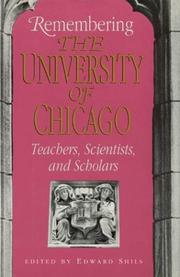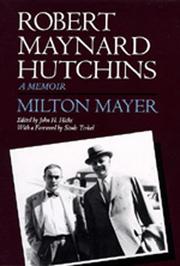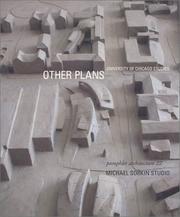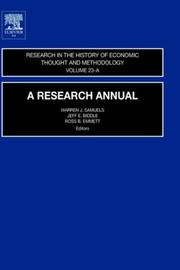| Listing 1 - 8 of 8 |
Sort by
|

ISBN: 0226753352 Year: 1991 Publisher: Chicago University of Chicago press
Abstract | Keywords | Export | Availability | Bookmark
 Loading...
Loading...Choose an application
- Reference Manager
- EndNote
- RefWorks (Direct export to RefWorks)
University of Chicago --- Chicago. --- Chicago Üniversitesi --- University of Chicago (1857-1886) --- Faculty --- Biography. --- History. --- Economic schools --- Higher education --- Chicago

ISBN: 0520070917 0585178372 Year: 1993 Publisher: Berkeley : University of California Press,
Abstract | Keywords | Export | Availability | Bookmark
 Loading...
Loading...Choose an application
- Reference Manager
- EndNote
- RefWorks (Direct export to RefWorks)
Educational Institutions --- Education --- Social Sciences --- Hutchins, Robert Maynard, --- University of Chicago --- Center for the Study of Democratic Institutions --- Presidents --- History. --- Ho-chʻin-ssu, --- Hutchins, Robert, --- Hutchins, Robert M. --- Chicago. --- Chicago Üniversitesi --- Robert Maynard Hutchins Center for the Study of Democratic Institutions (U.S.) --- Fund for the Republic --- University of Chicago (1857-1886)
Book
ISBN: 9781848556614 1848556616 1282271431 9786612271434 1848556608 9781848556607 9781282271432 6612271434 Year: 2009 Publisher: Bingley : Emerald JAI,
Abstract | Keywords | Export | Availability | Bookmark
 Loading...
Loading...Choose an application
- Reference Manager
- EndNote
- RefWorks (Direct export to RefWorks)
Volume 27C of Research in the History of Economic Thought and Methodology consists of documents from Glenn Johnson and F. Taylor Ostrander. Part I includes: notes from lectures by James E. Meade on the linking of monetary theory with the pure theory of value (Oxford University, 1932-1933); notes from the Socialist Club at the Cafe Verique in Geneva (Summer 1931); correspondence between Frank H. Knight and F. Taylor Ostrander; index to the Treasury Department papers of F. Taylor Ostrander; and notes on the long and wide-ranging career of F. Taylor Ostrander. Part II presents Glenn Johnson's notes from courses at the University of Chicago (1946); notes from Lloyd Mints' course on money and banking, economics 330 (Fall 1946); incomplete course notes from Milton Friedman's price theory, economics 300B, University of Chicago (Spring 1947); and notes from seminars by John R. Hicks and Tjalling Koopmans, University of Chicago (October 1946).
Economics. --- Economics --- Economic theory --- Political economy --- Social sciences --- Economic man --- Study and teaching (Higher) --- History --- University of Chicago --- Chicago. --- Chicago Üniversitesi --- University of Chicago (1857-1886) --- Tuition --- E-books --- Economics -- Study and teaching (Higher) -- Illinois -- Chicago -- History -- Sources. --- University of Chicago -- Tuition -- Sources. --- Economic Theory --- Business & Economics --- Economic history. --- Economic History. --- Methodology. --- Research.

ISBN: 1568983093 9781568983097 Year: 2001 Volume: 22 Publisher: New York, NY Princeton Architectural Press
Abstract | Keywords | Export | Availability | Bookmark
 Loading...
Loading...Choose an application
- Reference Manager
- EndNote
- RefWorks (Direct export to RefWorks)
"In 1998 Michael Sorkin was commissioned by the University of Chicago to produce an alternative to the official master plan for its architectural revitalization. His studio had barely begun before they were dropped from the process. However, as a concerned alumnus, Sorkin proceeded on his own and in Pamphlet Architecture 22, the Sorkin Studio presents their unsolicited scheme in models, colorful drawings and text." "When architect Steven Holl and publisher William Stout established the Pamphlet Architecture series in 1978, their intention was to provide an independent vehicle to criticize, question and exchange views. Each pamphlet was chosen, according to Holl, for its "independence and intensity of spirit" and for its polemical arguments, unified collection of concepts, and clear point of view. In Pamphlet Architecture 22, Michael Sorkin provides concrete evidence of a visionary ideal and an exemplar of what remarkable architecture and planning can mean today."--BOOK JACKET.
University of Chicago --- Buildings --- History. --- Planning --- Bâtiment universitaire --- History --- Constructions --- Histoire --- Planification --- 72.07 --- 727.3 --- Sorkin, Michael --- Universiteitsgebouwen --- Architecten. Stedenbouwkundigen A - Z --- Gebouwen voor opleiding en wetenschap ; universiteiten, hogescholen --- Chicago. --- Chicago Üniversitesi --- University of Chicago (1857-1886) --- Sorkin, Michael °1948 (°Washington D.C., Verenigde Staten)
Book
ISBN: 1487583354 9781487583354 9781487582067 Year: 2018 Publisher: Toronto
Abstract | Keywords | Export | Availability | Bookmark
 Loading...
Loading...Choose an application
- Reference Manager
- EndNote
- RefWorks (Direct export to RefWorks)
Ernest Sirluck's life has been full of passion and, not infrequently conflict. His childhood and youth as a Jew in a predominantly Mennonite Prairie village, his service as a divisional intelligence officer in Europe during the Second World War, and his experience as a professor and university administrator during a period of dramatic changes produced a man of firm convictions and the ability to fight for them. His story charts his many battles: against antisemitism and Nazism, mediocrity and academic complacency, ideological zealotry, and government and union encroachment on university autonomy. But he is, first and foremost, an educator, and his autobiography provides an intimate intellectual history of mid-century universities, spiced with anecdotes about the many prominent educators he worked with, among them E.K. Brown, A.S.P. Woodhouse, Northrop Frye, and Marshall McLuhan. Born to Russian Jewish parents in Winkler, Manitoba, Sirluck, grew amidst the antisemitism of the 1930s. This was a particularly strong influence in his life -- the swastika-flaunting Canadian Nationalist Party, exploiting the misery of the Great Depression, had found a receptive audience for their Nazi-influenced propaganda in the German-speaking Mennonite community. During the Second World War, Sirluck interrupted his university education to serve in the field with the Canadian army in Europe. After the war he pursued his doctorate while teaching English literature at the University of Toronto, then was appointed to the University of Chicago, where he taught for fifteen years. When he eventually returned to the University of Toronto to become graduate dean and vice-president, he seized the opportunity to initiate an inter-university rationalization of graduate studies and library services throughout Ontario. Subsequently he was appointed president of the University of Manitoba, where a reduced level of public funding and the influence of a union-oriented government led to the university's general unionization and its first strikes. The special value of this work lies in the unique perspective that Sirluck brings to familiar and unfamiliar event and issues. His deeply held beliefs, persuasive analytical powers, and richly detailed memories combine to make this a fascinating autobiography.
College teachers --- Sirluck, Ernest, --- University of Toronto. --- University of Manitoba. --- University of Chicago. --- University of Manitoba --- University of Toronto --- University of Chicago --- Chicago. --- Chicago Üniversitesi --- University of Chicago (1857-1886) --- U of T --- Université de Toronto --- Universitet Toronto --- UToronto --- University of King's College (Toronto, Ont.) --- Manitoba. --- Manitobsʹkyĭ universytet --- Université du Manitoba --- U of M --- UM
Book
ISBN: 022624265X 9780226242651 9780226242514 022624251X 9780226381206 022638120X Year: 2015 Publisher: Chicago : University of Chicago Press,
Abstract | Keywords | Export | Availability | Bookmark
 Loading...
Loading...Choose an application
- Reference Manager
- EndNote
- RefWorks (Direct export to RefWorks)
One of the most influential institutions of higher learning in the world, the University of Chicago has a powerful and distinct identity, and its name is synonymous with intellectual rigor. With nearly 170,000 alumni living and working in more than 150 countries, its impact is far-reaching and long-lasting. With The University of Chicago: A History, John W. Boyer, Dean of the College since 1992, presents a deeply researched and comprehensive history of the university. Boyer has mined the archives, exploring the school's complex and sometimes controversial past to set myth and hearsay apart from fact. The result is a fascinating narrative of a legendary academic community, one that brings to light the nature of its academic culture and curricula, the experience of its students, its engagement with Chicago's civic community, and the conditions that have enabled the university to survive and sustain itself through decades of change. Boyer's extensive research shows that the University of Chicago's identity is profoundly interwoven with its history, and that history is unique in the annals of American higher education. After a little-known false start in the mid-nineteenth century, it achieved remarkable early successes, yet in the 1950s it faced a collapse of undergraduate enrollment, which proved fiscally debilitating for decades. Throughout, the university retained its fierce commitment to a distinctive, intense academic culture marked by intellectual merit and free debate, allowing it to rise to international acclaim. Today it maintains a strong obligation to serve the larger community through its connections to alumni, to the city of Chicago, and increasingly to its global community. Published to coincide with the 125th anniversary of the university, this must-have reference will appeal to alumni and anyone interested in the history of higher education of the United States.
Universities and colleges --- History. --- Harper, William Rainey, --- Hutchins, Robert Maynard, --- University of Chicago --- University of Chicago (1857-1886) --- higher ed, continuing education, american universities, university of chicago, distinct identity, intellectual rigor, comprehensive history, archives, controversial past, fascinating narrative, legendary academic community, culture and curricula, undergraduate enrollment, financial troubles, decline, international acclaim, vivid anecdotes, myth, senator stephen a douglas, william rainey harper, robert maynard hutchins.
Book
ISBN: 1283362945 9786613362940 0226905632 9780226905631 9781283362948 9780226905617 0226905616 Year: 2011 Publisher: Chicago : University of Chicago Press,
Abstract | Keywords | Export | Availability | Bookmark
 Loading...
Loading...Choose an application
- Reference Manager
- EndNote
- RefWorks (Direct export to RefWorks)
When championing the commercial buildings and homes that made the Windy City famous, one can't help but mention the brilliant names of their architects-Daniel Burnham, Louis Sullivan, and Frank Lloyd Wright, among others. But few people are aware of Henry Ives Cobb (1859-1931), the man responsible for an extraordinarily rich chapter in the city's turn-of-the-century building boom, and fewer still realize Cobb's lasting importance as a designer of the private and public institutions that continue to enrich Chicago's exceptional architectural heritage. Henry Ives Cobb's Chicago is the first book about this distinguished architect and the magnificent buildings he created, including the Newberry Library, the Chicago Historical Society, the Chicago Athletic Association, the Fisheries Building for the 1893 World's Fair, and the Chicago Federal Building. Cobb filled a huge institutional void with his inventive Romanesque and Gothic buildings-something that the other architect-giants, occupied largely with residential and commercial work, did not do. Edward W. Wolner argues that these constructions and the enterprises they housed-including the first buildings and master plan for the University of Chicago-signaled that the city had come of age, that its leaders were finally pursuing the highest ambitions in the realms of culture and intellect. Assembling a cast of colorful characters from a free-wheeling age gone by, and including over 140 images of Cobb's most creative buildings, Henry Ives Cobb's Chicago is a rare achievement: a dynamic portrait of an architect whose institutional designs decisively changed the city's identity during its most critical phase of development.
Architecture --- Cobb, Henry Ives, --- University of Chicago --- University of Chicago (1857-1886) --- Chicago. --- Chicago Üniversitesi --- Buildings. --- Cobb, Henry Ives --- Illinois (Etat) --- Chicago (Ill.) --- Buildings --- henry ives cobb, architecture, chicago, skyline, commercial buildings, metropolis, city, urban, 1893 worlds fair, fisheries building, athletic association, historical society, newberry library, gothic, romanesque, university, union club, social mobility, class, growth, expansion, wealth, owings, opera house, pennsylvania state capitol, nonfiction, history.

ISBN: 0762311649 0762311657 0762311665 1849503184 9786610631568 1280631562 0080460348 1849503176 9786610631551 1280631554 008046033X 1849503168 9786610631544 1280631546 0080460313 9781849503181 9781849503174 9781849503167 9780080460338 9780080460345 9780080460314 9780762311644 Year: 2005 Publisher: Amsterdam ; San Diego, Calif. : Elsevier JAI,
Abstract | Keywords | Export | Availability | Bookmark
 Loading...
Loading...Choose an application
- Reference Manager
- EndNote
- RefWorks (Direct export to RefWorks)
Volume 23C of this research annual first presents lecture notes from courses at the University of Wisconsin during 1955-6 given by Hans Hl. Gerth and Edwin E. Witte, together with correspondence of Selig Perlman. The volume also presents notes taken by F. Taylor Ostrander in courses given at the University of Chicago during 1933-4. The notes are from courses given by John U. Nef, Charles O. Hardy, and Chester W. Wright, on European economic history, money and banking, and U.S. economic history, respectively.
AA / International- internationaal --- 330.40 --- Geschiedenis van het economisch en sociaal denken --- Evolution historique de la pensée économique et sociale: généralités --- History of the economic and social thinking --- 330.40 Geschiedenis van het economisch en sociaal denken --- 330.40 Evolution historique de la pensée économique et sociale: généralités --- 330.40 History of the economic and social thinking --- Geschiedenis van het economisch en sociaal denken. --- Economics --- Economic theory --- Political economy --- Social sciences --- Economic man --- History --- Economists --- Social scientists --- Methodology --- Economics. --- Study and teaching (Higher) --- University of Wisconsin --- University of Chicago --- Chicago. --- Chicago Üniversitesi --- University of Chicago (1857-1886) --- Wisconsin. --- Wisconsin State University --- University of Wisconsin--Madison --- Tuition --- Business & Economics --- Economic history. --- General. --- Methodology. --- Research. --- Science
| Listing 1 - 8 of 8 |
Sort by
|

 Search
Search Feedback
Feedback About
About Help
Help News
News